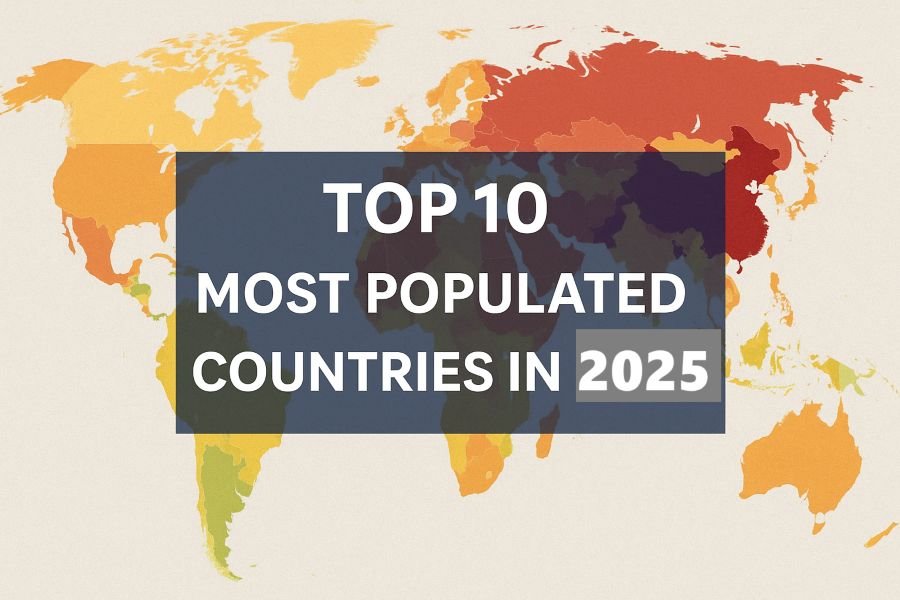
As we know In 2024, India has surpassed China to become the world’s most populous country, marking a significant shift in global demographics. This change reflects broader trends in population growth, urbanization, and economic development across the globe. Understanding these dynamics is crucial for policymakers, businesses, and individuals alike.
Top 10 Most Populated Countries in 2025
According to the World Population Review, the top ten most populous countries in 2025 are:
- India: 1,441,719,852
- China: 1,425,178,782
- United States: 341,814,420
- Indonesia: 279,798,049
- Pakistan: 245,209,815
- Nigeria: 229,152,217
- Brazil: 217,637,297
- Bangladesh: 174,701,211
- Russia: 143,957,079
- Ethiopia: 129,719,719
Detailed Insights into the Top 10
- India: With a population exceeding 1.44 billion, India has taken the lead as the most populous country. The nation’s youthful demographic, with a median age of around 28 years, presents both opportunities and challenges in terms of employment, education, and infrastructure development.
- China: China’s population stands at approximately 1.42 billion. However, the country is experiencing a demographic shift due to an aging population and declining birth rates, leading to a slight population decrease.
- United States: The U.S. population is about 341 million, with growth primarily driven by immigration. The country’s diverse demographic landscape continues to evolve, influencing its cultural and economic dynamics.
- Indonesia: As the largest country in Southeast Asia, Indonesia’s population of approximately 280 million is characterized by a young median age and rapid urbanization, contributing to its economic growth.
- Pakistan: Pakistan’s population has reached around 245 million, with a high growth rate of 1.96%. The country’s youthful population presents opportunities for economic development, provided that challenges in education and employment are addressed.
- Nigeria: Nigeria, the most populous country in Africa, has a population of about 229 million. With a growth rate of 2.39%, the country faces challenges related to infrastructure, healthcare, and education to support its rapidly growing population.
- Brazil: Brazil’s population stands at approximately 217 million. While growth has slowed, the country continues to play a significant role in South America’s economy and politics.
- Bangladesh: With a population of around 175 million, Bangladesh is one of the most densely populated countries globally. Despite its size, the country has made significant strides in economic development and poverty reduction.
- Russia: Russia’s population is approximately 144 million. The country is experiencing a demographic decline due to low birth rates and an aging population, posing challenges for its future labor force.
- Ethiopia: Ethiopia’s population has reached about 130 million, with a high growth rate of 2.52%. The country is focusing on economic reforms and infrastructure development to support its growing population.
Global Population Trends
The global population surpassed 8.0 billion in mid-November 2022, marking a significant increase from an estimated 2.5 billion people in 1950. This growth includes an additional 1 billion people since 2010 and 2 billion since 1998, according to the United Nations. The UN predicts that the world’s population will continue to rise, reaching 9.7 billion in 2050 and potentially peaking at nearly 10.4 billion in the mid-2080s.
Implications of Population Growth
Economic Development
Countries with growing populations, such as India and Nigeria, have the potential to harness their demographic dividends for economic growth. A young workforce can drive innovation, productivity, and consumption, provided that investments are made in education, healthcare, and job creation.
Urbanization
Rapid population growth often leads to increased urbanization, as seen in countries like Indonesia and Bangladesh. Urban areas can offer better access to services and employment opportunities but also pose challenges related to housing, transportation, and environmental sustainability.
Aging Populations
Conversely, countries like China and Russia are facing aging populations, which can strain social welfare systems and reduce the labor force. Addressing these challenges requires policies that encourage higher birth rates and support for the elderly.
Conclusion
Understanding the dynamics of population growth is crucial for addressing global challenges and opportunities. As countries navigate the complexities of demographic changes, strategic planning and international cooperation will be essential in promoting sustainable development and improving the quality of life for people worldwide.





